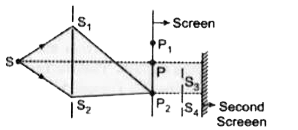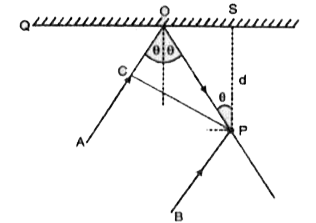Complete Solutions to MCQ LEVEL- II (PARAGRAPH QUESTIONS) of chapter WAVE OPTICS of Class 12 book with complete answers and questions
| Class 12 | PHYSICS |
| Chapter | WAVE OPTICS |
| MODERN PUBLICATION | MCQ LEVEL- II (PARAGRAPH QUESTIONS) |
| Number Of Questions | 28 |
| Academic Year | 2023-24 |
Questions 124 and 125 are based on paragraph given below: Unpolarised light of intensity 32 W `m^(-2)` passes through three polarisers such that transmission axis of last polariser is crossed with first, the intensity of emergent light is 3 W`m^(-2)`.
124. The nagle between transmission axis of first two polarisers is
View SolutionThe angle at which transmission intensity is max. Is
View SolutionTwo towers on top of two hills are 40 km apart. The line joining them passes 50 m above a hill halfway between the towers. What is the longest wavelength of radio waves, which can be sent between the towers without apprreciable diffraction effects?
View SolutionLight passes successively through two polarimeter tubes each of length 0.29m. The first tube contains dextrorotatory solution of concentration 60 kg `m^(-3)` and specific rotation 0.01 rad `m^(2) kg^(-1)`. The second tube contains laevo-rotatory solution of concentration 30 kg `m^(-3)` and specific rotation 0.2 rad `m^(2) kg^(-1)`.The net rotation produced is :
View SolutionThe human eye has an approximate angular resolution of `phi = 5.8 xx 10^(-4)` rad and a typical photprinter prints a minimum of 300 dpi (dots per inch = 2.54 cm). At what minimal distance z should a printed page be held so that one does not see the individual dots ?
View SolutionFor the same objective , the ratio of the least separation between two points to be distinguisghed by a microscope for light of `5000 Å` and electrons accelerated through 100 V used as the illuminating substance is
View SolutionConsider a two slit interferennce arrangements such that the distance of the screen from the slits is half the distance between the slits.That the first minima on the screen falls at a distance D from the centre O, then D is

View SolutionFigure shows a two slit arrangement with a source which emits unpolarised light P is a polariser with axis whose direction is not given. If `I_(0)` is the intensity of the principal maxima when no polariser is present then the intensity of the principal maxima as well as of the first minima are

View SolutionAC = CO = D , `S_(1) C = S_(2) C = d ltlt D`
A small transparent slab containing material of `mu = 1.5` is placed along `AS_(2)`. What will be the distance from O of the principal maxima

View SolutionA beam of light is passed through a polaroid and the latter is rotated with the beam of light as axis. The intensity of the emergent light varies between a maximum and a minimum.Then the light used is :
View SolutionFigure shows a two slit arrangement with slits `S_(1), S_(2), P_(1), P_(2)` are the two minima ponts on either side of P(Fig). At `P_(2)` on the screen, there is a hole and behind `P_(2)` is a second 2-slit arranngement with slits `S_(3), S_(4)` and a second screen behind them

View SolutionTwo source `S_(1)` and `S_(2)` of intensity `I_(1)` and `I_(2)` are placed in front of a screen [Fig. A]. The pattern of intensity distribution seen in the central portion is given by Fig.(b). In this case which of the following statements are true
(a)
View SolutionConsider sunlight incident on a pinhole of width `10^(3)Å`. The image of the pinhold seen on a screen shall be
View SolutionRed light of wavelength `6500 Å` from a distant source falls on a slit 0.50 mm wide. What is the distance between the two dark bands on each side of the central bright band of the diffraction pattern observed on a screen placed 1.8 m from the slit.
View SolutionFraunhoffer diffraction experiment at a single slit using light of wavelength 400 mm, the first minima is formed at an angle of `30^(@)`. Then the direction `theta` of the first secondary maximum is given by :
View SolutionTwo beams of light having intensities I and 4I interfere to produce a fringe pattern on the screen.Phase differenced between the beams is `(pi)/(2)` at point A and `pi` at point B.Then difference between the resultant intensities at A and B is :
View SolutionIn double slit experiment, when a glass plate of `mu = 1.5` ans thickness t is introduced in path of one of the interfering beams of wavelengths `lambda`, the intensity at position of central maxima remains unchanged. Minimum thickness of glass plate is :
View SolutionOn fig. CP represents a wavefront and AO and BP, the corresponding two rays. Find the condition on `theta` for constructive interference at P between the ray BP and reflected ray OP :

View SolutionIn a Young's double slit experiment, bi - chromatic light of wavelengths 400 nm and 560 nm are used.The distance between slits is 0.1 mm and distance between plane of slits and screen is 1 m.The minimum distance between two successive regions of complete darkness is :
View SolutionTwo pointa white dots are 1 mm apart on a black paper.They are viewed by eye of pupil of diameter 3 mm. Nearly what is max. Distance at which these dots can be resolved by eye?(`lambda` of light is 500 mm)
View SolutionWhen an unpolarised light of intensity `I_(0)` is incident on a polarised sheet, the intensity of light which does not get transmitted is :
View SolutionIn Young's double slit experiment, the intensity at a point is 1/4 of maximum intensity, angular position of this point is ?
View SolutionThe intensity at a point where the path difference is `(lambda)/(6)`(`lambda` being the wavelength of the light used) is I. If `I_(0)` denotes the maximum intensity, `(I)/(I_(0))` is equal to :
View SolutionIn double slit experiment, the angular width of the fringes is `0.20^(@)` for the sodium light `(lambda = 5890 Å`). In order to increase the angular width of the fringe by 10%, the necessary change in the wavelength is :
View SolutionA mixture of light, consisting of wavelength 590 nm and unknown wavelength, illuminates Young's double slit and gives rise to two overlapping interference patterns on the screen.The central maximum of both lights coincide.Futther, it is observed that the third bright fringe of known light coincides with the 4th bright firnge of the unknown light.From this data, the wavelength of the unknown light is :
View SolutionQuestions numbers 149-150 are based on the following paragraph :
A nucleus of mass M + `Deltam` is at rest and decays into two daughter nuclei of equal mass `M/2` each. Spped of light is c.
149. The speed of daughter nuclei is :
View SolutionThe binding energy per nucleon for the parent nucleus is `E_(1)` and that for the daughter nuclei is `E_(2)`. Then :
View SolutionIn a Young's double slit experiment, the separation between the two slits is d and the wavelength of the light is `lambda`.The intensity of light falling on slit 1 is four times the intensity of light falling on slit 2.Choose the correct choice(s).
View Solution
MCQ LEVEL- II (PARAGRAPH QUESTIONS) questions and complete solutions for chapter WAVE OPTICS of MODERN PUBLICATION PHYSICS (KANNADA ENGLISH) of Class 12